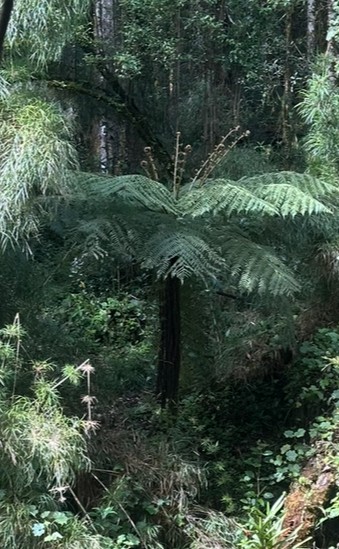Tree fern
The two main genera of hardy tree ferns are Cyathea and Dicksonia. Species of Dicksonia are readily identified by hairs growing on the newly emerging fronds, and the most common Cyathea species can be identified by the presence of scales on many (but not all) species.[1] They are among the most ancient botanical species on earth. They originated during the Carboniferous Period, roughly 360 million years ago. Members of both Cyatheaceae and Dicksoniaceae appear to have been diverse and relatively common during the succeeding Jurassic Period (199.6 to 145.5 million years ago) and Cretaceous Period (145.5 to 65.5 million years ago). However, the modern genera only became evident during the early Cenozoic (65.5 to 2.6 million years ago).[2]

Description
Tree ferns do not develop a woody trunk that functions like other trees. All ferns have a rhizome, from which the fronds emerge. These rhizomes can vary (from species to species) from long to short, or be creeping along the ground. A tree fern is simply a case of the rhizome being very long and strong enough to support itself.[1]
Leaves of all ferns, including tree ferns, are referred to as fronds. On tree ferns, the fronds are held at the top of the plant in a spreading manner. They form by uncurling from the crown in the center, which is at the top of the trunk. The crown might be considered the most important part of the plant, since that is where all the leaf growth comes from. If it is destroyed, no more croziers will emerge from it, and the rest of the plant will eventually die.[1]
Reproduction
Unlike most plants, tree ferns do not reproduce via flowers or seeds but through spores. If the leaves reach maturity, they unfold into leafy fronds and develop spores on the underside of the fronds. When the spores germinate, they transform into minuscule plants.[4]
Distribution and Habitat
Tree ferns are widely distributed in tropical and subtropical regions, with significant populations in Southeast Asia, Australasia, and the Americas. They thrive in humid forests, especially in mountainous regions with high rainfall. Some species can also be found in temperate rainforests, particularly in countries like Costa Rica, New Zealand, and Chile. Species found at lower elevations are often widespread colonizers of disturbed or successional habitats.[2]
Ecology
Tree ferns play a crucial role in forest ecosystems. Their fibrous trunks provide habitats for epiphytic plants, mosses, and ferns, supporting a diverse range of species. Tree ferns can harvest water both through the soil and aerially through the stem and fronds. The root masses of tree ferns accumulate organic material, contributing to nutrient cycling and improving soil fertility. Studies have found that tree ferns provide double the amount of nitrogen in the soil that canopy trees produce and three times the amount of phosphorus. In disturbed forests, tree ferns often act as pioneer species, stabilizing the soil and creating microhabitats that facilitate the regeneration of other plant species.[5]
Species
The exact number of tree fern species is uncertain, but notable species include:[5]
- Cyathea dealbata – Commonly known as the silver fern or ponga, it is endemic to New Zealand and recognized by the distinctive silver-white coloration on the underside of its fronds.
- Dicksonia antarctica – Known as the soft tree fern or Tasmanian tree fern, it is native to southeastern Australia and is one of the most abundant tree ferns in the region.
- Cyathea medullaris – Referred to as the black tree fern or mamaku, it is native to New Zealand and some Pacific islands, known for its fast growth and large fronds, grows in open places with full exposure to wind and sun.
- Sphaeropteris excelsa – This species can reach heights of up to 20 meters, with fronds extending up to 5 meters in length.
- Cyathea smithii – The southernmost naturally occurring tree fern, adapted to cooler temperate climates.[5]
New Zealand Species
Cyatheaceae – scaly tree ferns[5]
- Cyathea cunninghamii
- C. dealbata (Silver fern)
- C. medullaris (Black tree fern)
- C. smithii (Soft tree fern)
- C. colensoi
- C. kermadecensis
- C. milnei
Dicksoniaceae – hairy tree ferns
- Dicksonia lanata
- D. fibrosa
- D. squarrosa
Use and Management
Indigenous communities in the southern temperate regions have historically used tree ferns for various purposes, such as food, medicine, and construction. In New Zealand and Australia, tree ferns have been harvested for commercial use, including ornamental gardening and fencing, though concerns about sustainability have led to the establishment of nurseries.[5] While tree ferns can support forest ecosystems, they may also hinder tree regeneration in some areas, leading to selective management efforts, particularly in places where they have become invasive, such as Hawaii.
References
- ↑ 1.0 1.1 1.2 Itb. "Cold-Hardy Tree Ferns Page." Angelfire. www.angelfire.com/bc/eucalyptus/treeferns/. Accessed 31 Mar. 2025.
- ↑ 2.0 2.1 Yatskievych, George; Mickel, John T.; Wagner, Warren H.; Gifford, Ernest M.; Walker, Warren F. "Fern." Encyclopedia Britannica, 22 Mar. 2025. Tree Fern – Britannica.
- ↑ User. "Tree fern in Costa Rica." Photograph taken in the cloud rainforest of Costa Rica by Ethan Bannister, January 2025.
- ↑ Cindy. "Costa Rica – Flora Focus: Tree Ferns." Conscious Explorer. https://conscious-explorer.com/magazine/costa-rica-flora-focus-tree-ferns. Accessed 9 May 2025.
- ↑ 5.0 5.1 5.2 5.3 5.4 Donoghue, Shavawn, and Perpetua A. M. Turner. “A Review of Australian Tree Fern Ecology in Forest Communities.” Austral Ecology 47, no. 2 (April 2022): 145–165. https://doi.org/10.1111/aec.13103.